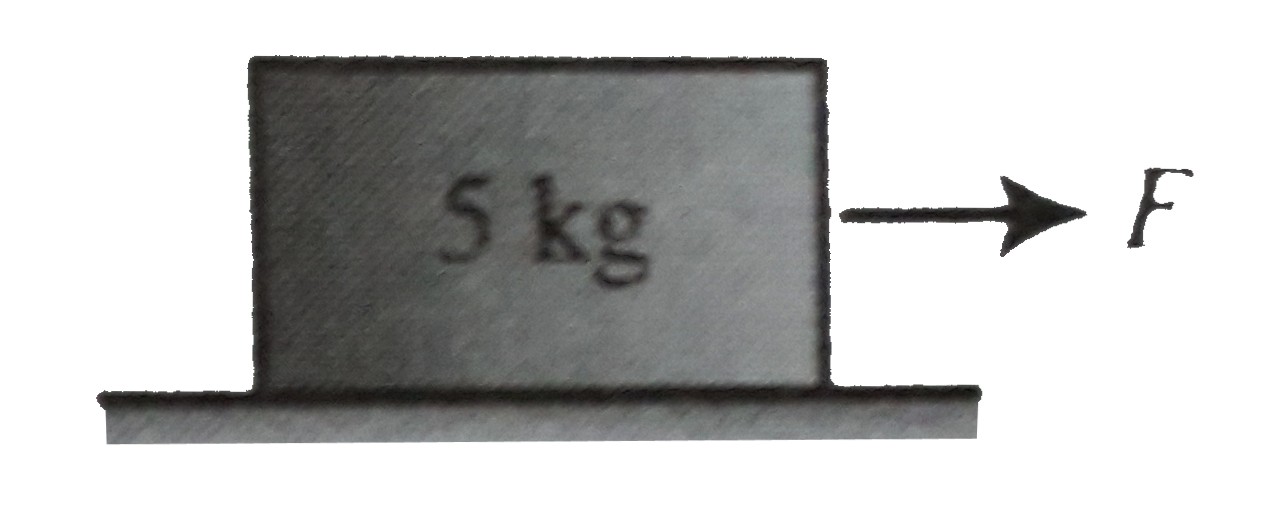A body of mass 25 kg is at rest on a horizontal surface. Minimum horizontal force required to just start motion is 73.5N and a force of 49N is needed to keep the body moving with a constant velocity. What is the coefficient of (i) static friction and (ii) kinetic friction ?
To solve the problem, we need to find the coefficients of static and kinetic friction for a body of mass 25 kg on a horizontal surface. We are given the following information:
- Mass of the body (m) = 25 kg
- Minimum horizontal force required to just start motion (F_s) = 73.5 N
- Force needed to keep the body moving with constant velocity (F_k) = 49 N
- Acceleration due to gravity (g) = 9.8 m/s²
Step 1: Calculate the Normal Force (R)
The normal force (R) acting on the body is equal to its weight when on a horizontal surface. The weight (W) can be calculated as:
W=m⋅g
Substituting the values:
W=25kg⋅9.8m/s2=245N
Thus, the normal force R=245N.
Step 2: Calculate the Coefficient of Static Friction (μ_s)
The force of static friction (F_s) is given by:
Fs=μs⋅R
We know that the minimum force required to start motion is equal to the force of static friction:
73.5N=μs⋅245N
Now, we can solve for μs:
μs=73.5N245N≈0.3
Step 3: Calculate the Coefficient of Kinetic Friction (μ_k)
The force of kinetic friction (F_k) is given by:
Fk=μk⋅R
Since the force needed to keep the body moving with constant velocity is equal to the force of kinetic friction:
49N=μk⋅245N
Now, we can solve for μk:
μk=49N245N≈0.2
Final Answers:
- Coefficient of static friction (μ_s) = 0.3
- Coefficient of kinetic friction (μ_k) = 0.2
- Minimum horizontal force required to just start motion (F_s) = 73.5 N
- Force needed to keep the body moving with constant velocity (F_k) = 49 N
- Acceleration due to gravity (g) = 9.8 m/s²
The normal force (R) acting on the body is equal to its weight when on a horizontal surface. The weight (W) can be calculated as:
W=m⋅g
Substituting the values:
W=25kg⋅9.8m/s2=245N
Thus, the normal force R=245N.
The force of static friction (F_s) is given by:
Fs=μs⋅R
We know that the minimum force required to start motion is equal to the force of static friction:
73.5N=μs⋅245N
Now, we can solve for μs:
μs=73.5N245N≈0.3
The force of kinetic friction (F_k) is given by:
Fk=μk⋅R
Since the force needed to keep the body moving with constant velocity is equal to the force of kinetic friction:
49N=μk⋅245N
Now, we can solve for μk:
μk=49N245N≈0.2
- Coefficient of static friction (μ_s) = 0.3
- Coefficient of kinetic friction (μ_k) = 0.2
Topper's Solved these Questions
- BOOK - ICSECHAPTER - FRICTIONEXERCISE - Additional solved examples9videos
FRICTION
- BOOK - ICSECHAPTER - FRICTIONEXERCISE - Conceptual short answer questions with answer9videos
FRICTION
- BOOK - ICSECHAPTER - DYNAMICSEXERCISE - SHORT ANSWER QUESTIONS WITH ANSWERS12videos
DYNAMICS
- BOOK - ICSECHAPTER - GRAVITATIONEXERCISE - FROM THE HUBBLE TELESCOP2videos
GRAVITATION
Similar Questions
A20 kg block is initally at rest. A 75 N force is required to set the block in motion. After the motion starts, a force of 60 N is required to keep the block moving with constant speed. The coefficient of static friction is
View SolutionA block of mass 5kg rests on a rough horizontal surface. It is found that a force of 10N is required to make the block just move However , once the motion begains, a force of only 8N is enough to maintain the motion find the coefficient of kinetic and static friction between the block and the horizontal surface
 View Solution
View Solution
Knowledge Check
- Question 1 - Select One
A 20 kg block is initially at rest. A 75 N force is required to set the block in motion. After the motion a force of 60 N is applied to keep the block moving with constant speed. The coefficient of static friction is
A0.6B0.52C0.44D0.35
A block of mass 5kg rests on a rough horizontal surface. It is found that a force of 10N is required to make the block just move However , once the motion begains, a force of only 8N is enough to maintain the motion find the coefficient of kinetic and static friction between the block and the horizontal surface
 View Solution
View SolutionA block of mass 2 kg rests on a horizontal surface. If a horizontal force of 5 N is applied on the block, the frictional force on it is (take,uk=0.4,μs=0.5)
View SolutionA force of 49 N just able to move a block of wood weighing 10 kg on a rough horizontal surface , then coefficient of friction is
View SolutionA body of mass 2kg is kept on a rough horizontal surface as shown in the figure. If coefficient of friction is 0.5, find the work done by frictional force in the interval t=0 to t=5sec
 View Solution
View SolutionA body of mass 2kg is placed on a horizontal surface having kinetic friction 0.4 and static friction 0.5 . If the force applied on the body is 2.5N , then the frictional force acting on the body will be
View SolutionA horizontal force of 1N is needed to keep a block of mass 0.25kg sliding on a horizontal surface with a constant speed. Find the coefficient of sliding friction. (g=10ms−2)
View SolutionA body of mass 5 kg moving on a horizontal surface with a velocity of 10ms−1 comes to rest in 2s. The force required to make this body move with a velocity of 10ms−1 on the same surface is
View Solution

